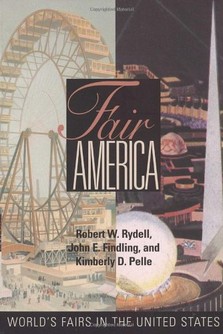Sunsphere and the 1982 Knoxville World's Fair
Introduction
Text-to-speech Audio
Images
The Sunsphere reflected the theme of the exposition, "Energy Moves the World." In the wake of two major oil embargoes and rising fuel prices, energy was a leading concern of many Americans throughout the 1970s.

For the history of this and other World Fairs in the 19th and 20th centuries, please read Robert Rydell's book, Fair America: World Fairs in the United States

Backstory and Context
Text-to-speech Audio
Constructed in 1981, the 266-foot tall Sunsphere contains three high-speed elevators that whisk guests up twenty-six stories. The iconic twenty-four-karat gold windows were achieved by placing vinyl film with gold dust lamented to it in between the glass panes. The finished gold panes cost about one thousand dollars each when they were created. At that time, the color of the tower’s base was sky blue, though it has since been repainted forest green.
The idea of having the world’s fair in Knoxville, Tennessee was W. Stewart Evans’. Evans was the president of the Downtown Knoxville Association. Evans approached Mayor Kyle Testerman who went to banker Jake Butcher for financial advice. The abandoned Louisville and Nashville Railroad Yard was demolished to make room for the fair, which was the first World’s Fair in the South.
President Ronald Regan opened the fair on May 1, 1982, and it remained open for five months, hosting over eleven million visitors. During the fair’s opening ceremonies, a band played from the top of the Sunsphere to the people from 22 nations present. The fair earned the city $25 million in tax revenue and $500 million in tourism revenue. Famous inventions that were presented at the fair included the Rubik’s Cube, Cherry Coke, and touchscreen monitors.
The Knoxville, Tennessee 1982 World’s Fair cost $115 million and left Knoxville with $57 million in public debt and vacant buildings in the months after the fair took place. The Tennessee banking business controlled by Jake Butcher, chairman of the fair and Knoxville financer, left the city with more problems.
One day after the fair ended on October 1, 1982, Federal bank examiners took control of Butcher’s 22 banks. In February of 1983, the United American Bank of Knoxville was the first of Butcher’s banks to be insolvent. Eight more banks were declared insolvent after this. This was the biggest set of bank failures in the United States since the Great Depression. The collapse of Butcher’s banks resulted in a lack of security in their plans for renovating the site after the fair. In 1984, William Schmidt of the New York Times reported that the old fairgrounds were only popular with local joggers who liked the deserted footpaths found there.
Although the Observation Deck and Sunsphere are two of the highlights of the downtown area today, they have had a complicated and often controversial past, with many public debates about what might be done with space and who should cover the expense of the facility's renovation and operation. Mayor Bill Haslam announced plans to renovate and reopen the Sunsphere, as well as the amphitheater, in 2005. In 2007, these plans were finally realized and the following year, the Sunsphere received its first paying tenant when a private company moved into the floors above the observation deck. Updates, such as a new HVAC system, new LED lighting, and upgrades to the elevators and plumbing, were undertaken in 2018.
Sources
The Sunsphere at World’s Fair Park. Visit Knoxville Tennessee. Accessed January 25, 2019. https://www.visitknoxville.com/things-to-do/tours/sunsphere/.
Construction Facts. Sunsphere. Accessed January 25, 2019. http://www.sunsphere.info/.
Whetstone, Tyler. Knoxville City Council approves $2.5M for Sunsphere, Amphitheater improvements. Knox News. August 15, 2018. Accessed January 25, 2019. https://www.knoxnews.com/story/news/local/2018/08/15/knoxville-city-council-approves-25-m-sunsphere-improvements/981350002/.
History. World's Fair Park. Accessed January 27, 2019. http://worldsfairpark.org/history.html.
Wheeler, Bruce. Knoxville World's Fair of 1982. Tennessee Encyclopedia. October 08, 2017. Accessed January 27, 2019. https://tennesseeencyclopedia.net/entries/knoxville-worlds-fair-of-1982/.
Trieu, Cat. Remembering the 1982 World’s Fair. University of Tennessee Daily Beacon. November 16, 2017. Accessed January 27, 2019. http://www.utdailybeacon.com/arts_and_culture/lifestyle/remembering-the-world-s-fair/article_7f68471c-ca7e-11e7-b14f-17dc38318998.html.
Schmidt, William. The Desolate Legacy of Knoxville's World's Fair. The New York Times. May 18, 1984. Accessed January 27, 2019. https://www.nytimes.com/1984/05/18/us/the-desolate-legacy-of-knoxville-s-world-s-fair.html.
